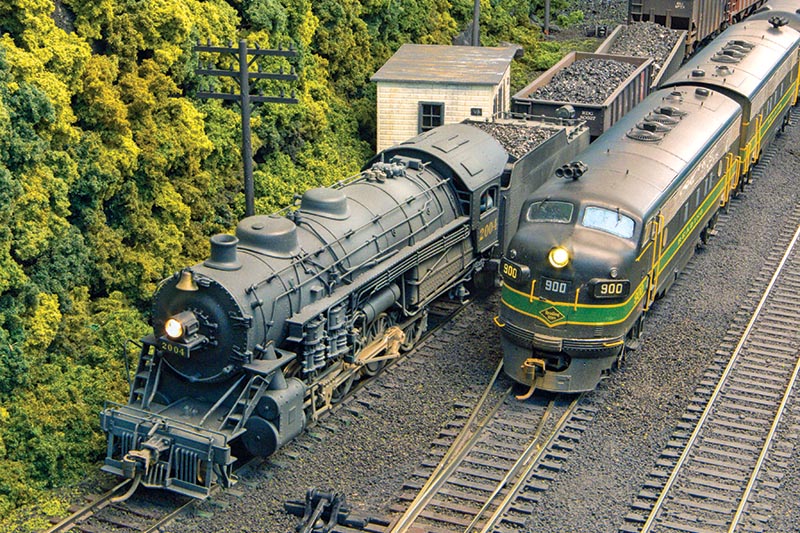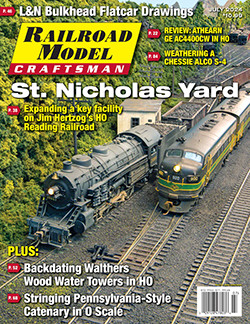 Jim Hertzog/photos by Mike Rinkunas
Jim Hertzog/photos by Mike Rinkunas
Anthracite has long been considered the highest grade of coal, thanks to its high carbon content and low amount of impurities, resulting in the highest energy content. Northeastern Pennsylvania is home to the largest naturally occurring deposits of anthracite, with the earliest mining taking place at Pottsville in 1790, and quickly gained popularity as a home heating fuel by 1810 in addition to its use in manufacturing steel. Philadelphia & Reading Railroad was chartered in 1833 to connect Philadelphia with the mines at Pottsville. The railroad continued to expand its territory serving mines throughout eastern Pennsylvania, becoming one of the “anthracite roads” competing for traffic, along with Delaware, Lackawanna & Western; Central Railroad of New Jersey; Lehigh Valley Railroad; and other connecting lines. By the 1920s, the railroad was referred to as the “Reading,” operating 1,460 miles at its peak.
During the first half of the 20th century the St. Nicholas Yard facility was an important gathering and storage hub for anthracite on the Reading Railroad. The large yard, located just west of the hard coal mining community of Mahanoy City, Pa., had more than twenty tracks and bordered the large St. Nicholas central breaker complex.
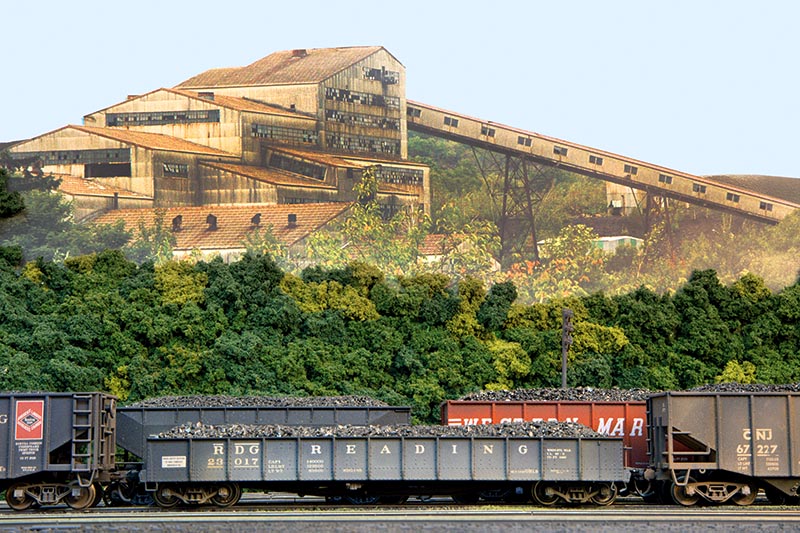
ABOVE: A photo print of the actual St. Nicholas breaker was glued to the backdrop. With no space to model the building, a photo enlargement was a good stand-in.
Because St. Nicholas Yard lacked any scales for weighing coal, shuttle trains were usually assigned to take the loaded hoppers for weighing at one of three scales located at either Tamaqua, St. Clair or Shamokin yards. Previously weighed coal was sometimes returned to St. Nicholas for storage until needed. From a modeler’s perspective the yard offered a unique loads-in/loads out scenario. St. Nicholas Yard also stored the empty hoppers for use at the adjacent colliery.
Opened in 1932, the St. Nicholas colliery encompassed hundreds of acres and could produce over 12,000 tons of anthracite each day. It was constructed to replace several smaller wooden coal breakers and would be a central site for coal processing. Along with a sister breaker at Locust Summit, the St. Nicholas facility would be responsible for anthracite processing in the Mahanoy district of eastern Pennsylvania. As sizable as both plants were, both lacked any tangible locomotive servicing areas, with main line trains, mine turns, and yard engines working the facilities.
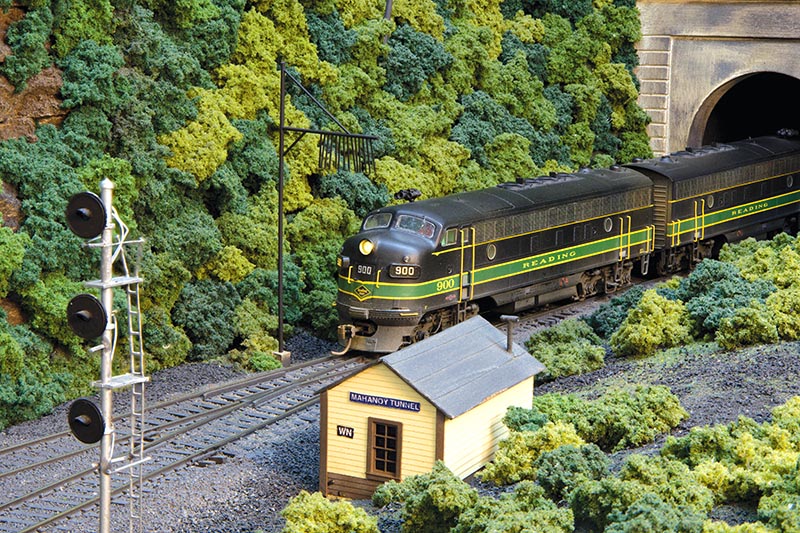
ABOVE: Train 97, the westbound King Coal passenger train from Philadelphia to Shamokin, is shown exiting Mahanoy Tunnel at WN office.
By mid-century the demand for anthracite continued to rapidly spiral downward as less expensive natural gas and oil took over the market for home heating. The St. Nicholas complex continued operating until 1965 when the economics of coal mining permanently closed it. Over the next fifty years many of the mining structures were razed along with most of the trackage. Finally in 2018 the remaining breaker building was demolished.
Layout Design
When I designed my HO scale Reading Shamokin Division nearly twenty-five years ago (See August 2015, August 2019, and August 2021 Railroad Model Craftsman) the track plan dictated that my version of St. Nicholas Yard and the adjoining town of Mahanoy City would be situated near a corner basement wall allowing little room for any further development. A curved backdrop would conceal, but still allow access to, a circuit breaker panel. My abridged version of St. Nicholas was designed for an area only 16 inches wide by six feet long, permitting space for only three yard tracks.
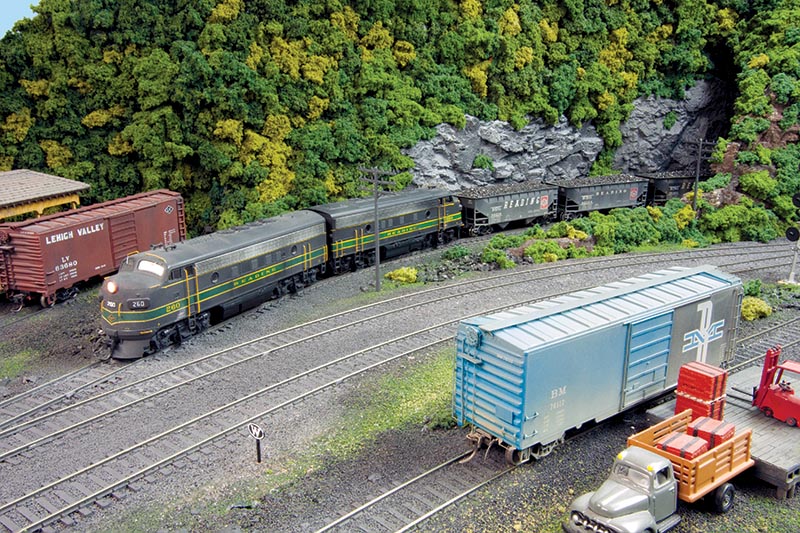
ABOVE: The Colliery Crew headed by a pair of EMD F-units is pulling several loads from the Tunnel Ridge Colliery spur before continuing west to St. Nicholas yard. The unmodeled mine, represented by a pair of tracks running off into the hillside, contributes 4-6 loads each op session.
Because of the space limitations, I knew that modeling the actual breaker building or any associated structures would be impossible, so I reproduced the breaker by using a photograph that I had taken several years earlier, as the structure was slowly being dismantled. The photograph was enlarged to a 16 x 20” print and then carefully trimmed and fastened to the backdrop. Foliage clusters were glued around the picture, giving the appearance of looking across the valley. I decided against adding any hidden mine tracks behind the hillside, deeming this too risky and stressful for the operating crews. Visible trackage at a busy yard is always preferred over anything hidden.
A few years later I removed some of the background scenery, which included a narrow mine access road, and added a short mine lead track. The new lead gave the appearance of heading toward the colliery photograph. At the end of the mine lead I affixed a small mirror, giving the look of leaving the main yard area and heading to the colliery. During the remodeling, I was also able to squeeze in two very short spurs with a capacity for nine more hopper cars. However, as my interest in model railroad operations grew, I observed that my version of St. Nicholas Yard was capable of replicating only a small portion of the actual operations. I wanted to include many (if not all) of the trains which worked the yard, but the very limited track length hindered my plans…


